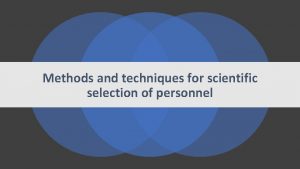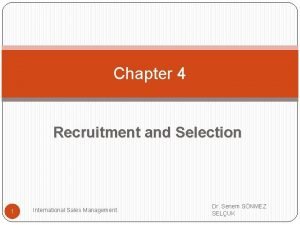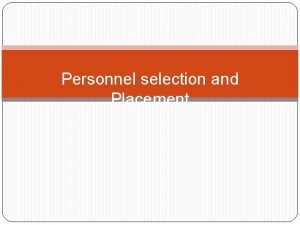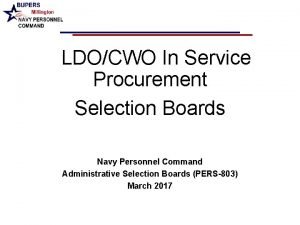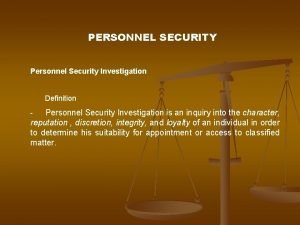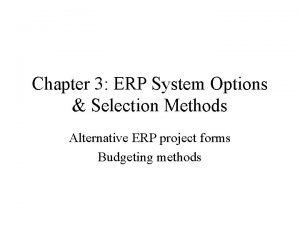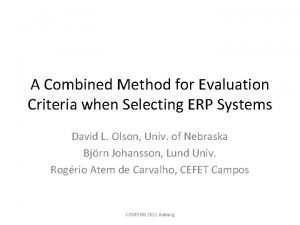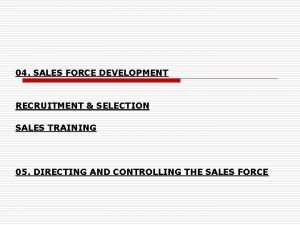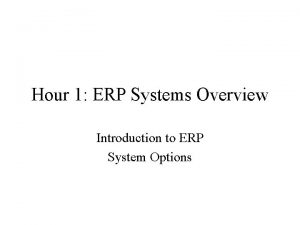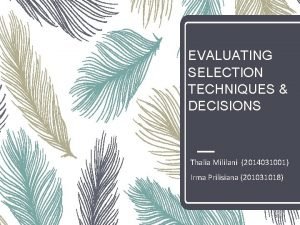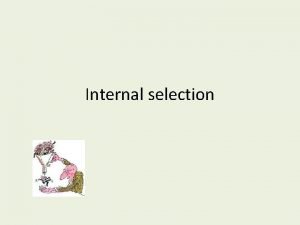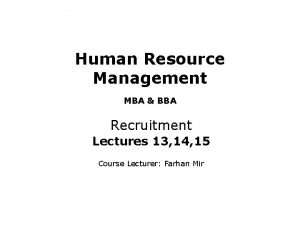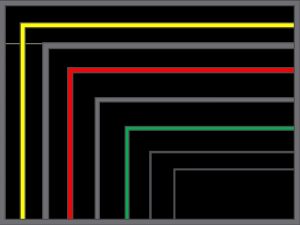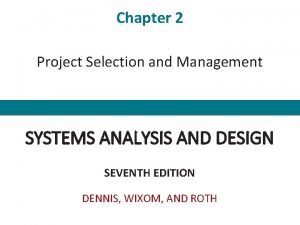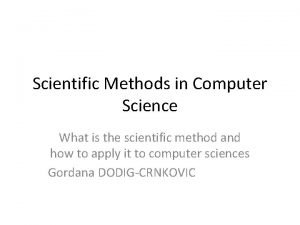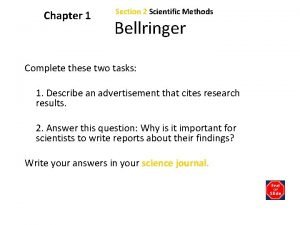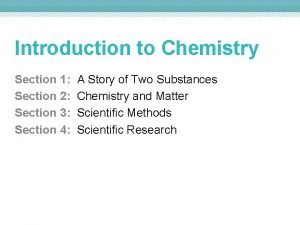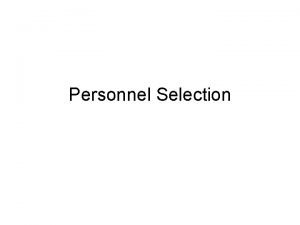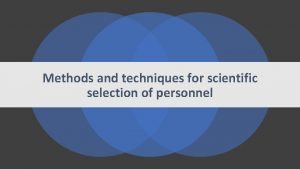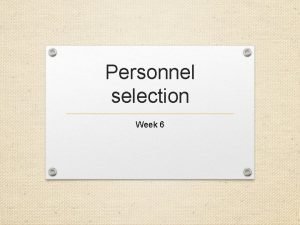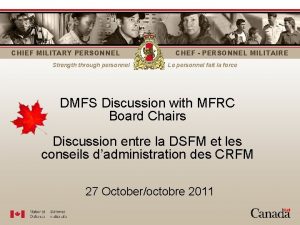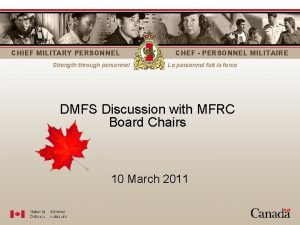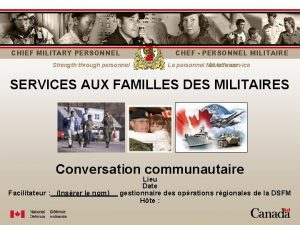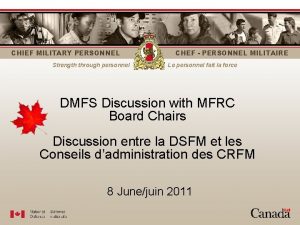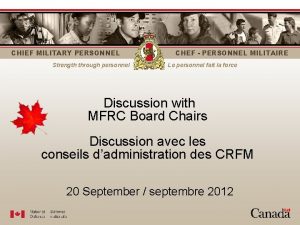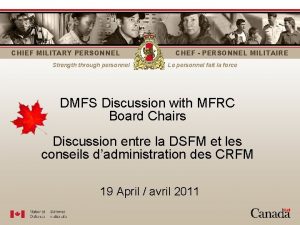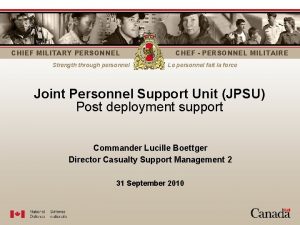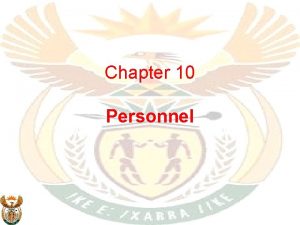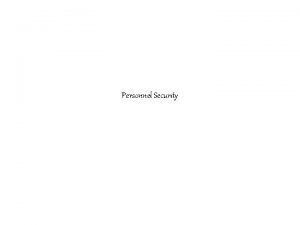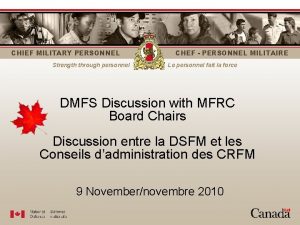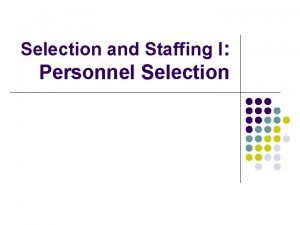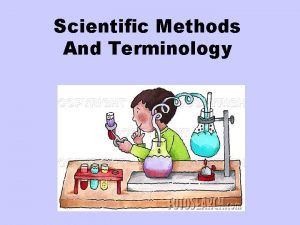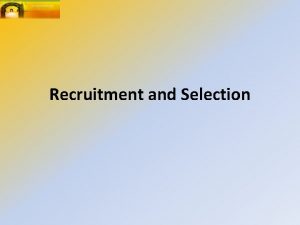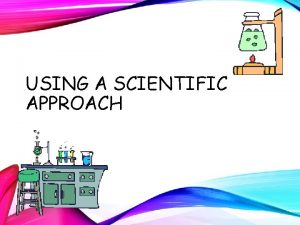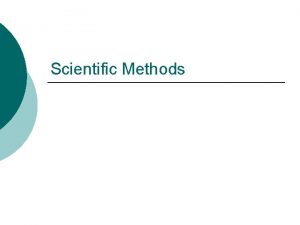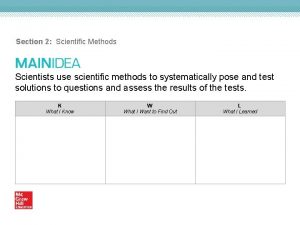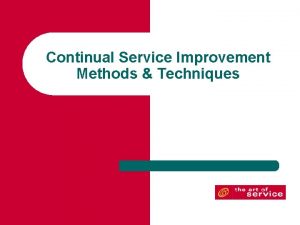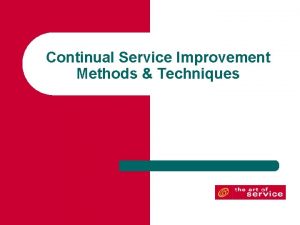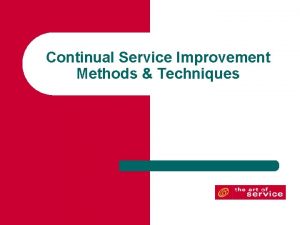Methods and techniques for scientific selection of personnel


































- Slides: 34

Methods and techniques for scientific selection of personnel

Selection of personnel 2

Selection of personnel A methodical process used for hiring people Recruitment Selection Hiring 3

Selection of personnel The selected candidates are separated from the rejected candidates with the intention of choosing the person who will make the most valuable contributions to the organization The selection procedure follows the data collection strategy for a person 4

Methods and techniques for personnel selection 1 Traditional selection process 2 A combination of three selection methods • Registration forms, • Interviews, • References. 5

Selection measures Methods and techniques for personnel selection • Human resources managers use a variety of measures/ tools to select candidates that best fit their position. The main purpose of these tests is to predict and quantify the performance of the job, and each test has its own strengths and limitations relative to consider. 6

Methods and techniques for personnel selection • • Interviews Personality tests Select biographical data Skills test 7

Research in personnel selection The interview and the results of the research centers' are reviewed and are discussed periodically. In both cases, one of the measured key constructs appears to be, in general, cognitive ability. Values of data validity and processes used to develop biographical data tools are also critically reviewed. 8

Personal development plan It can be defined as an instrument that: • Provides an overview of the competences that the employee has developed in the past and the skills that the employee intends to develop in the future • It is made by the employee • It is used as the basis for structuring conversations with the manager that gives the employee feedback and stimulates the employee's reflection • It serves to make different decisions, ranging from the planning of an individual training program to the decision whether or not to give a person a promotion 9

Work Socialization The initial integration method for new employees is socialization, guided adaptation to the company's climate, workplace and workgroup. A training program that occurs when an employee starts working with an organization. 10

Stages of the socialization process • Stage before arrival • Stage of the meeting • Stage of metamorphosis 11

Scientific selection of personnel 12

• Scientific selection is more than just a set of tests and interviews, it's more than scientific validation • It refers to some aspects, namely: Needs analysis, The importance of the selection context, Comparing test results with organizational results, Preparing a correct report and the correct communication of its results, Monitoring of results, Implementation after selection of training, guidance and socialization processes 13

Organization needs analysis First, it is necessary to evaluate the organization. It is necessary to collect as much information as possible about the job, so that the selection process is as specific as possible. 14

Collecting data about the objective of the selection procedure Basic set of tools for a correct needs analysis Coaching strategies to help the candidate define their goal Needs Analysis: Helps the company to define its best goals, it helps to achieve the objectives of evaluation and selection 15

The individual interview. Semistructured is the most used tool for needs analysis. Basic set of tools for a correct needs analysis Group interviews. Choosing a group of employees in the target department is a useful strategy to understand the strengths and weaknesses of the department. Analysis of organizational culture. A set of hypotheses that a person does about the group they are participating in. These assumptions are grouped into three levels: artefacts (physical, visible elements); beliefs and values (strategies, goals, declared philosophies), basic beliefs (assumed beliefs, unconscious) as a rule the most difficult to change. 16

A list together with the beneficiary with all the required skills. Suggestions for a proper needs analysis A list with the beneficiary with all personality traits desired. Ordination of skills and personality traits, from the most important to the least important. Indirect observation of the beneficiary's management style. A list of key performance indicators for the job and how they are measured. 17

Information about that job. Suggestions for a proper needs analysis Information about the previous selection process. Find any traps and blockages that may have created problems in the previous selection process. If possible, record the audio or video of the meeting. Time does not exceed one hour (40 minutes is optimal). 18

Define the specific tasks that the employee (tasks) must fulfill. Suggestions for interview analysis Request a description of a typical day of work. Start with the first task you have to accomplish when entering the company. After the first task, what does the employee have to do next? Observing the non-verbal behavior of the interviewee (for example: laughter is a form of suppression of aggression). 19

It is done through psychometric tests or questionnaires, with group exercises. Here are some suggestions for collecting information about organizational culture. Organizational culture Provides an indication of cultural gaps: distance between norms and employee perceptions. The four variables studied are social relations, personal freedom, support burden, innovation task. Organizational Culture Inventory is a test designed by Cooke and Lafferty (Cooke, Rousseau, 1988; Cooke and Lafferty, 1989; Cooke, Szumal, 1993; Van der Velde and Class, 1995). 20

Organizational culture can be measured in two dimensions Task orientation vs. people orientation Development orientation vs safety orientation This measurement allows the classification of organizational culture into one of these three groups: constructive culture, aggressive-defensive culture, passive-defensive culture. 21

Defining the desired candidate profile • Description of the interview (location, key person (s) - you can use a single document if it is a group interview, multiple documents if you have more than one individual interview) • Skills list • List of personality traits • List of hypotheses for key interviewee • KPI list (key performance indicators) • List of key beliefs about the connections between the individual characteristics and performance profile • Previous Job Analysis of Job Opportunities (if any) 22

Analysis of specific indicators. For example, a test of defense mechanisms. This does not mean nothing unless we read the specific indicators. We should ask ourselves the following question: What specific definition of defense mechanisms is included? Psychometric tests What are the specific indicators included in the test? Which validity and reliability indicators are satisfactory? How do these indicators relate to the desired results? What are the specific research that shows that indicators connect to the desired results? 23

Questionnaires Personality tests Big Five Personality Model NEO-PI 3 Test 24

Intelligence Tests Fluid intelligence test Crystallized intelligence test 25

Motivation tests Measuring the motivation style The measured variables are: selfconfidence, selfregulation, ambition 26

Behavior analysis in the staff selection process 27

Behavior analysis during the selection process The interview is the most widespread instrument The flexibility of an interview, on the one hand, can help the interviewer adapt to the characteristics of the candidate or put him in difficulty, especially as regards the objective. The behavioral interview reduces the probability of error 28

Behavioral analysis is what we practice more or less when we interact with a person. Rules for a fair behavioral analysis Interpreting people is certainly a more difficult and less linear task. A very careful observation, but without the method, can lead to incorrect assessments. 29

The attitude of the behavioralist analyst must be to collect as many indicators as possible before transposing them (meaning the investigator's logic) Accumulation of Behaviors: At this stage, indicators are collected in the form of behavior Rules for a fair behavioral analysis Formulating a hypothesis Verifying the hypothesis 30

Analysis of verbal communication One of the first questions that the person who is preparing for the selection thinks is: "What do I have to say? " Using adjectives Words are controlled at a conscious level How the person talks about himself Use of Person I, III The emotional tone Excessive use of negative terms Extreme and exclusive use of positive adjectives 31

The individual interview Level of structure of the interview Selected behavior (friendly, professional, stressful interview). 32

Group interview is a method used to detect the subject interaction in social contexts. It is particularly useful in cases where group work is important. Group interview is often used as a complement to individual interview to confront the two instruments. A candidate may indeed declare that he has a great ability to work in a group but then does not disclose it in the real example of interaction with the group. 33

Thank you for your attention! 34
 Scientific selection process in hrm
Scientific selection process in hrm Recruitment and selection of sales personnel
Recruitment and selection of sales personnel Preliminary interview
Preliminary interview Selection and placement
Selection and placement European personnel selection office
European personnel selection office Personnel selection board
Personnel selection board Carnet personnel de techniques professionnelles
Carnet personnel de techniques professionnelles Explain security investigation
Explain security investigation Erp system options and selection methods
Erp system options and selection methods Erp evaluation criteria
Erp evaluation criteria Recruitment of sales force
Recruitment of sales force Introduction to erp systems
Introduction to erp systems Two way selection and multiway selection in c
Two way selection and multiway selection in c Two way selection and multiway selection in c
Two way selection and multiway selection in c Mass selection and pure line selection
Mass selection and pure line selection Thalia mililani
Thalia mililani A-wax pattern recognition
A-wax pattern recognition Internal selection methods
Internal selection methods Selection methods in hrm
Selection methods in hrm Portfolio management steps
Portfolio management steps Selection of teaching methods
Selection of teaching methods What are the project selection methods
What are the project selection methods Balancing selection vs stabilizing selection
Balancing selection vs stabilizing selection Similarities
Similarities K selection r selection
K selection r selection Natural selection vs artificial selection
Natural selection vs artificial selection Artificial selection vs natural selection
Artificial selection vs natural selection What is stabilizing selection
What is stabilizing selection What is exponential growth in ecology
What is exponential growth in ecology Natural selection vs artificial selection
Natural selection vs artificial selection Scientific methods in computer science
Scientific methods in computer science Chapter 1 section 2 scientific methods answer key
Chapter 1 section 2 scientific methods answer key Introduction to chemistry section 3 scientific methods
Introduction to chemistry section 3 scientific methods Information gathered during an experiment
Information gathered during an experiment How is a scientific law different from a scientific theory?
How is a scientific law different from a scientific theory?
